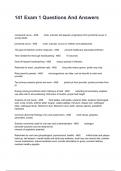141 Exam 1 Questions And Answers
compound nevus - ANS mole- macular and papular, progresses from junctional nevus in
young adults
junctional nevus - ANS mole- macular, occurs in children and adolescents
The goal of infection control measures - ANS prevent healthcare associated infection
Time needed for thorough handwashing - ANS 15 seconds
Goal of frequent handwashing - ANS reduce spread of infection
Rationale for short, unpolished nails - ANS long nails harbor germs, polish may chip
Risk posed by jewelry - ANS microorganisms can hide, can be harmful to client and
provider
Two primary reasons gloves are worn - ANS protect pt from provider, protect provider from
pt
Energy saving procedures when making a pt bed - ANS collecting all necessary supplies,
use side rails to aid positioning, fold linens in fourths, proper bed height
Anatomy of oral cavity - ANS hard palate, soft palate, posterior pillar, posterior pharyngeal
wall, uvula, tonsils, anterior pillar, tongue, valate papillae, frenulum, lingual vein, sublingual
folds, sublingual ducts, Wharton's duct, Stensen's duct, teeth, salivary glands, partial/full
hardware
Common abnormal findings of an oral assessment - ANS tooth decay, gingivitis,
perionditis, sordes
Solution commonly used for oral care and contraindication - ANS hydrogen
peroxide-cytotoxic (can be destructive)
mineral oil-aspiration potential
Rationales for oral care (physiological, psychosocial, health) - ANS inhibit tartar and plaque
build-up, self esteem, overall health and total body wellness, tooth loss can restrict diet, moisten
mucus membranes, reduce bacterial count, provide stimulation to gums, prevent halitosis,
maintain healthy appetite
,Why we focus on oral health and oral care - ANS changes general health
-nutrition
-communication
-CAD: correlation between poor oral health and higher risk if pt has artificial valve
-preterm labor: correlation
Key purposes for the use of anti-embolism stockings - ANS maintain external pressure on
muscles and lower extremities, reduce thrombus formation
-require flexion and muscle retraction for venous return to be effective
-used with sequential compression devices (promotes venous return)
Contraindications for anti-embolism stockings - ANS displaced edema
could lead to heart failure
(must be physician ordered)
Why it's important to have correct size for anti-embolism stockings - ANS -Too large is
ineffective and there can be wrinkles
-Wrinkles can cause skin break down
-Too small can restrict circulation and cause too much pressure
How often do anti-embolism socks need to be removed? - ANS At least once in an 8 hour
period/shift
Why is it important to remove anti-embolism stockings? - ANS Allows observation of
circulatory status, color, temp, condition. Palpate pedal pulses.
Difference between primary and secondary lesion - ANS Primary lesion is the immediate
result of a specific cause that develops on previously unaltered skin. (Bulla, Urticaria)
Secondary lesions result from change in primary lesions over time. (Scratching, Infection)
Important documentation of unidentified lesion - ANS color, pattern, elevation, size,
location/distribution, exudate, odor
Primary action to ensure wheelchair safety - ANS breaks
Wheelchair fit is important - ANS possibility of impaired skin integrity
Positioning is important in wheelchair or in bed - ANS maintain body alignment, prevent
complications, airway
Why it's important to maintain proper body mechanics during transfer - ANS avoid injuries
to healthcare provider, avoid injury to pt
, Two of the primary muscle groups for pt transfer - ANS Quadriceps Femoris, Gluteus
Maximus
Purpose of a lift team - ANS prevent healthcare provider injury, more people to assist with
lift
Actions nurse can take to prevent lift injury - ANS -lift with primary muscle groups
-use proper body mechanics
-bending at knees instead of waist
-avoid twisting
When should mechanical lift be used - ANS -pt is heavy
-pt is extremely incapacitated
-pt is non-weight bearing
Different types of mechanical lifts - ANS -sling
-sit to stand
(use depends on pt ability to bear weight and pt's level of strength)
QSEN (Quality and Safety Education in Nursing) - ANS Safety
Collaboration and Teamwork
Informatics
Evidence-based Practice
Patient-centered Care
Quality Improvement
Safety - ANS Minimize risk of harm to pts and providers through both system effectiveness
and individual performance. Ex: Examine human factors and basic safety design principles and
commonly used unsafe practices. Value own role in preventing errors
Collaboration and Teamwork - ANS Function effectively within nursing and
interprofessional teams, fostering open communication, mutual respect, and shared decision
making to achieve quality pt care. Ex: Recognize the contributions of other health team
members and pt's family members. Discuss effective strategies for communicating and
resolving conflict. Participate in designing methods to support effective teamwork.
Informatics - ANS Use information and technology to communicate, manage knowledge,
mitigate error, and support decision-making. Ex: Navigate an electronic health record. Protect
confidentiality of protected health information in electronic health records.
Evidence-based Practice - ANS Integrate best current evidence with clinical expertise and
pt/family preferences and values for delivery of optimal health care. Ex: Demonstrate knowledge
of basic scientific methods. Appreciate strengths and weaknesses of scientific bases for
practice. Appreciate the importance of regularly reading relevant journals.




